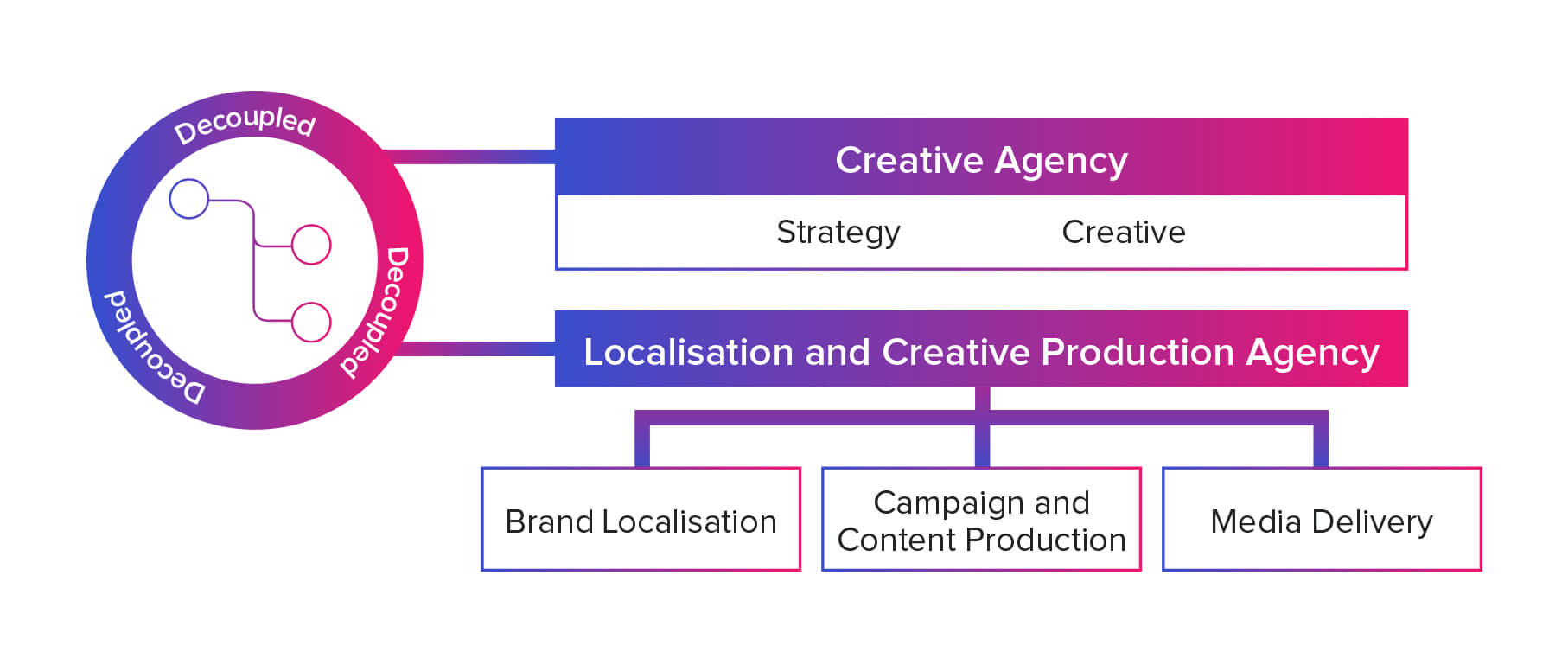
Decoupled Production is when a company separates production from ideation and media buying. Therefore, a chosen production house becomes responsible for the production work. Ultimately, creative ideas and assets are localised and transcreated into a spectrum of deliverables (that are consistent with the brand and master assets) for local markets. These deliverables are, then, distributed over the right media channels, at the right time, to the right target audience.
Distribution of responsibilities in Production Decoupling
Creative Agency
- Formulating Strategies
- Developing Creative Ideas
- Producing Master Content
Creative Production Agency
- Brand Localisation
- Campaign and Content Production
- Media Delivery
”Production decoupling or centralised production occurs when a client communicates directly with a production house instead of allowing their agency to produce in-house or use their own supplier.”
Production Decoupling models can contain one or more of the following approaches:
Client centred - completely removes the advertising agency from the production process and the client chooses and employs their own supplier.
Client & Agency cooperation - multiple ad agencies are utilised; the client uses their own supplier for production work, but production efforts are managed by the ad agencies.
Agency centred - agencies continue to handle the production relationship for clients and continue to manage the creative production.
Client & 3rd Party cooperation - client employs a production management company or a transcreation company to handle production work.
The practice of production decoupling has been a popular strategy for not only global brands but smaller businesses also. They can, then, outsource their production needs to specialist agencies with the experience, technology, capabilities and means to execute effective solutions, especially for clients needing complete, multi-channel, multi-language solutions.
Benefits include:
- Managing lower operating costs
- Faster time to market
- Consistency across local markets
- Managing multiple incremental workloads
Let’s look at production decoupling in more detail. As mentioned in the introduction, production decoupling refers to separating ideation from creation. Essentially, when decoupling is utilised, companies unbundle creative and strategy development from asset creation in order to improve speed, quality and lower production costs when executing advertising campaigns. This entails connecting the right type of talent with specific tasks and properly allocating production expertise and resources at the right times. Production decoupling allows a client’s creative agency to do what they do best: strategy, ideation and creation of master assets for global campaigns. Production work is assigned to the localisation hub, including copy transcreation, distributing assets over media channels in different markets, delivery to publishers, amongst others.
Over the past 10 years or so, agencies, traditionally, had the responsibility of creating ideas, producing said ideas (whether digital, print or TV) and communicating them throughout various platforms. The problem is that, even though these agencies may be experts in advertising and coming up with creative strategies, they may not be as knowledgeable in the areas of offline and online production. With production decoupling, advertising, marketing or brand agencies are asked to develop only core ideas, allowing them to focus on creating the most effective campaigns and leaving content production to specialist production houses, which are able to offer specialised expertise, deliver more quickly and at lower costs.
Creative Agency:
- Global Creative Strategy
- Global Creative Ideation
- Master Assets Building
Creative Production Hub:
- Local Assets Building
- Local Assets Localisation / Transcreation
- Local Assets Publishing
- Local Assets Storage
In Production Decoupling, brands let their creative agencies do only what they are best at: formulating strategies, developing creative ideas, producing master content. And they let their Creative Production agencies to what they are best at: transcreation of copy, dissemination of assets across media types, roll-out to markets, delivery to publishers.
Production decoupling first started with the establishment of independent print houses, but has since been used in media buying and in the production of advertising deliverables. These days, the latest trends in production decoupling focus on a wide range of services, including web-based, software development, digital and offline media assets, TV and more. In fact, there is an ongoing debate between marketers on whether media production should be used as a stand-alone service or not. For some companies, utilising three separate agencies – one solely focused on creative strategy, the second on creative production and the third on media delivery – may be necessary in order to execute successful advertising campaigns.
Procurement can be helpful in identifying production houses that best meet the marketing department’s needs. And naturally, as collaboration between procurement and marketing departments evolve, production decoupling is more frequently discussed. Sourcing experts are responsible for finding opportunities to save on costs and marketers must stay current with the latest trends in their fields in order to create the best production decoupling strategy to meet the objectives of both parties.
Although production decoupling’s intention is to cut costs and improve efficiency, detail-oriented creatives argue that relinquishing production responsibilities may achieve less than desirable results. In contrast, procurement professionals argue that for example creating multiple versions of the same online banner is a waste of the agency’s talent and resources. Another argument is that creative agencies don’t have the capacity to produce and distribute on the global scale that production houses excel at. These houses offer other unique benefits as well, such as tracking which assets have been deployed and offering a central database of translations that can be reused.


Because today’s advertising campaigns tend to be global and multi-channel, there is an argument that “garden” and “factory” models should be implemented. Gardens grow ideas, whereas factories manufacture them. In this regard, garden agencies are costly because they are staffed with expensive talent who are expert problem solvers, work in expensive offices, often in expensive cities. On the other hand, the factory model is where companies can focus on cutting costs. This gives the ability to achieve higher cost efficiencies given the nature of the work. Therefore, the factory model is low cost, in lower-cost offices, in lower-cost locations usually near-shore or off-shore.





